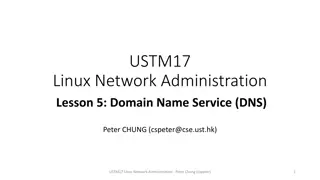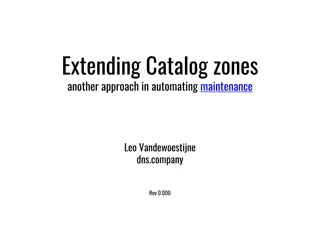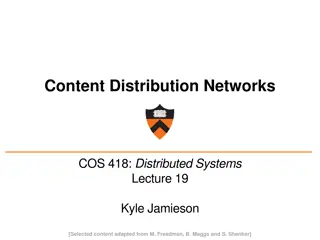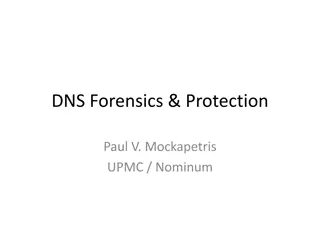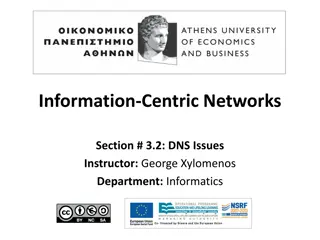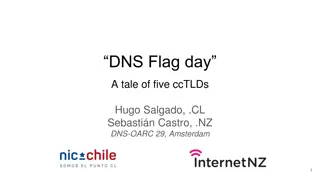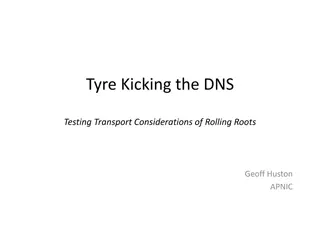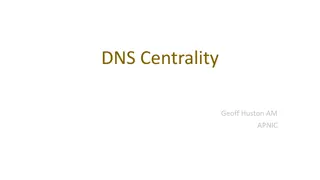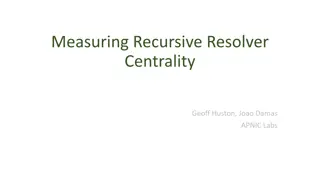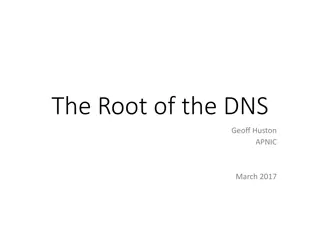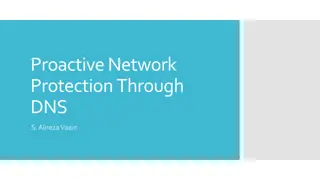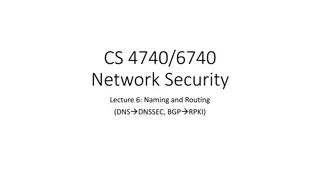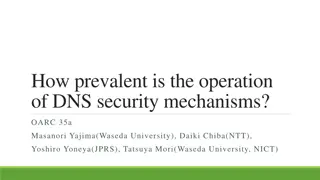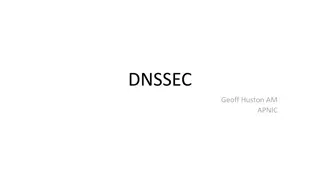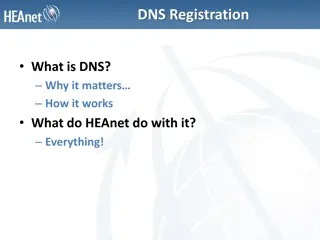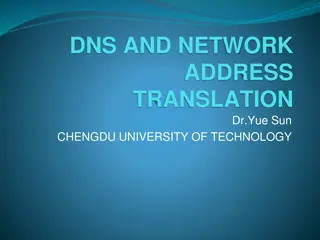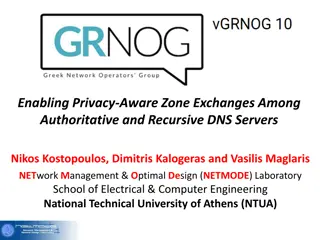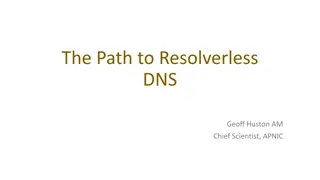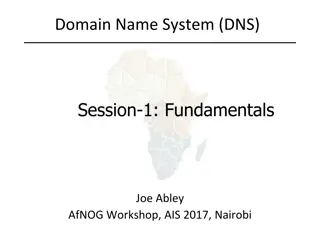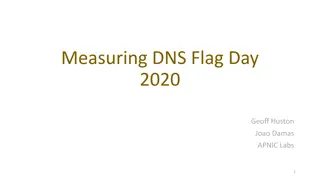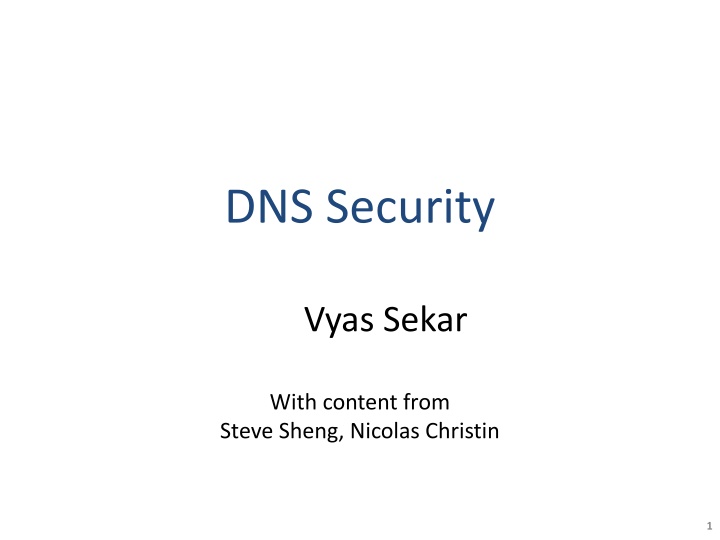
Understand DNS Security and Vulnerabilities in Networking Systems
Explore the world of DNS security and vulnerabilities with insights from experts Vyas Sekar, Steve Sheng, and Nicolas Christin. Dive into the fundamentals of DNS, learn about common resource records, and understand DNS attacks and DNSsec protocol. Discover the architecture of the Domain Name System (DNS) and its critical role in mapping names to IP addresses. Stay updated on upcoming project milestones and enhance your knowledge of DNS protocols.
Download Presentation

Please find below an Image/Link to download the presentation.
The content on the website is provided AS IS for your information and personal use only. It may not be sold, licensed, or shared on other websites without obtaining consent from the author. If you encounter any issues during the download, it is possible that the publisher has removed the file from their server.
You are allowed to download the files provided on this website for personal or commercial use, subject to the condition that they are used lawfully. All files are the property of their respective owners.
The content on the website is provided AS IS for your information and personal use only. It may not be sold, licensed, or shared on other websites without obtaining consent from the author.
E N D
Presentation Transcript
DNS Security Vyas Sekar With content from Steve Sheng, Nicolas Christin 1
Logistics Midterm exam Midterm grades Reviews Project milestone coming up! Lecture schedule fix Anon next class Censorship on Mar 25 Project milestone on Mar 27 2
Goals of this lecture Overview of DNS Understand DNS attacks DNSSec protocol 3
The Domain Name System DNS database maps: Name to IP address www.cmu.edu = 128.2.10.162 root .edu .mil .uk And many other mappings (mail servers, IPv6, reverse ) Data organized as tree structure: Each zone is authoritative for its own data Minimal coordination between zone operators cmu darpa usmc mil ece alpha 4
The Domain Name System A.root-servers.net B.root-servers.net C.root-servers.net D.root-servers.net E.root-servers.net F.root-servers.net G.root-servers.net H.root-servers.net I.root-servers.net root .edu .mil .gov Each zone has a set of authoritative servers Parent zones can contain pointers to the start of authority for a child zone, or root hints for peer zones A.gov-servers.net B.gov-servers.net 5
DNS Query and Response www.cmu.edu A? Root DNS Server www.cmu.edu A 128.2.10.162 End-user Caching DNS Server edu DNS Server cmu.edu DNS Server 6
Common Resource Records RECORD TYPE DESCRIPTION USAGE A An address record Maps FQDN into an IP address PTR A pointer record Maps an IP address into FQDN NS A name server record Denotes a name server for a zone SOA A Start of Authority record Specifies many attributes concerning the zone, such as the name of the domain (forward or inverse), administrative contact, the serial number of the zone, refresh interval, retry interval, etc. CNAME A canonical name record Defines an alias name and maps it to the absolute (canonical) name MX A Mail Exchanger record Used to redirect email for a given domain or host to another host 7
Goals of this lecture Overview of DNS Understand DNS attacks DNSSec protocol 8
DNS vulnerabilities Complete lack of authentication primitives Can redirect all DNS requests to a compromised server Can have a legitimate server send bogus replies Two techniques DNS cache poisoning DNS ID spoofing 9
DNS cache poisoning DNS servers cache DNS records for more efficiency The problem is that they let other DNS servers update the cache (zone transfer) without checking the records! What happens when a rogue DNS server updates the cache of a legit DNS server? 10
DNS cache poisoning 1. What is the IP of www.attacker.net? Attacker (host.whatever.com) DNS server dns.victim.com Victim (host.victim.com) Attacker (Rogue DNS server) dns.attacker.net 11
DNS cache poisoning 1. What is the IP of www.attacker.net? Attacker (host.whatever.com) DNS server dns.victim.com Victim (host.victim.com) Attacker (Rogue DNS server) dns.attacker.net 12
DNS cache poisoning 1. What is the IP of www.attacker.net? Attacker (host.whatever.com) DNS server dns.victim.com 3. www.attacker.net = 10.12.1.1 ZONE TRANSFER: MyBank.com = 10.0.1.1 Victim (host.victim.com) Attacker (Rogue DNS server) dns.attacker.net 13
DNS cache poisoning 1. What is the IP of www.attacker.net? Attacker (host.whatever.com) DNS server dns.victim.com 3. www.attacker.net = 10.12.1.1 ZONE TRANSFER: MyBank.com = 10.0.1.1 Victim (host.victim.com) Attacker (Rogue DNS server) dns.attacker.net 14
DNS cache poisoning 1. What is the IP of www.attacker.net? Attacker (host.whatever.com) DNS server dns.victim.com 3. www.attacker.net = 10.12.1.1 ZONE TRANSFER: MyBank.com = 10.0.1.1 Victim (host.victim.com) Attacker (Rogue DNS server) dns.attacker.net 15
DNS cache poisoning Problem Trusting anyone to hand out their zones A lot of DNS servers use outdated software BIND < 9.x, Remedies Block TCP/UDP port 53? (Zone transfer port) Only authorize zone transfers between trusted servers Extensively used in original pharming attacks Misdirecting users to fraudulent web sites 16
DNS ID spoofing Man in the middle attack Reply to requests claiming to be a DNS server Each DNS request contains an ID (nonce) Client verifies ID matches ID of its request Problem: no protection of the ID! 17
DNS ID spoofing Easy to do when sniffing network Limit of this attack? 18
DNS ID spoofing Easy to do when sniffing network Limit of this attack? Depends on winning the race condition 19
DNS ID spoofing Easy to do when sniffing network Limit of this attack? Depends on winning the race which is not too hard with ARP poisoning 20
DNS ID spoofing Easy to do when sniffing network Limit of this attack? Needs ability to spoof traffic! 21
DNS ID spoofing w/o wiretapping 65,536 possibilities for the ID field Relatively difficult to send 65,536 replies after the request has been issued before the reply from the legit DNS server is sent Are we safe? 22
DNS spoofing and birthday paradox Step 1: Attacker sends a large number of queries to victim name server, all for the same domain name Step 2: Attacker sends spoofed replies giving fake answers for the queries it made Step 3: At a later time, victim PC sends a request for the spoofed domain name Step 4: Victim name server returns fake information to victim PC (picture courtesy Lurhq.com) 23
Comments With the Birthday paradox, need roughly 700 packets to spoof answer with high probability But, the fake replies need to reply to the nameserver s source port number Source port number should change Unfortunately, BIND (and others) almost always use the same source port number Can send a recursive query to detect it Additional analysis tools can be used to predict port numbers 24
Defense: Split-Split DNS Serves domain info to outside world (no recursion allowed) Key idea: disable recursive queries from outside world Used for recursive queries from local users only, firewalled (picture courtesy Lurhq.com) 25
Goals of this lecture Overview of DNS Understand DNS attacks DNSSec protocol 26
DNS Security Extensions Uses public key cryptography to verify the authenticity of DNS zone data (records) DNSSEC zone data is digitally signed using a private key for that zone A DNS server receiving DNSSEC signed zone data can verify the origin and integrity of the data by checking the signature using the public key for that Zone 27
Authentication DNS Responses Each DNS zone signs its data using a private key. Recommend signing done offline in advance Query for a particular record returns: The requested resource record set. A signature (SIG) of the requested resource record set. Resolver authenticates response using public key. Public key is pre-configured or learned via a sequence of key records in the DNS hierarchy. 28
Secure DNS Query and Response Caching DNS Server www.cmu.edu www.cmu.edu = 128.2.10.162 Plus (RSA) signature by cmu.edu Attacker can not forge this answer without the cmu.edu private key. End-user Authoritative DNS Servers IETF DNS Security Extensions define the process for including signatures and keys in DNS 29
New Resource Records 3 Public key crypto related RRs RRSIG Signature over RRset made using private key DNSKEY Public key, needed for verifying a RRSIG DS Delegation Signer; Pointer for building chains of authentication One RR for internal consistency NSEC Indicates which name is the next one in the authenticated non-existence of data 30
Steps in Signing a zone Generate Public private key pair Secure storage of private keys Public key distribution Zone signing Key rollover Zone resigning 34
What is does and doesnt do Doesn t do Protect against host threats (DDoS, buffer overruns in code, etc.) Keep DNS data private Does Do: Establish the legitimacy of data retrieved from the DNS Protects end users from being redirected to malicious sites Allows any data stored in the DNS to be validated as trustworthy 35
Idea in Ateniese-Mangard paper Can we use symmetric key crypto instead? Key insight TTP can be online certification authority Hierarchically generate symmetric keys instead of using the PK certificates 38
Another interesting observation First observed in Galvin Ref [7] in Ateniese paper Requirements for PKI Availability Unique unambiguous names Real time access Verifiable bindings between names and keys DNSSEC could serve as a PKI! Already exists, it is a highly available system Very scalable due to hierarchy 39
Take away slide DNS built upon assumption people will behave normally Therefore highly vulnerable to attacks DNS attacks can allow an attacker to do pretty much whatever she wants with your traffic Almost no one uses IP addresses DNS recursion is the root of the problem Unfortunately, very convenient and hard to disable 40


